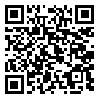BibTeX | RIS | EndNote | Medlars | ProCite | Reference Manager | RefWorks
Send citation to:
URL: http://jsdp.rcisp.ac.ir/article-1-383-en.html
Stress is one of the main causes of physical and mental disorders leading to various types of diseases. In recent two decades, stress level detection during driving to avoid accidents has attracted much of researchers’ attentions. However, the existing studies usually neglect this fact that stress level during driving varies due to irregular events. Contrary to the previous works, this paper demonstrates that to assume a fixed level of stress for a long period- e.g. while driving in highway- is unreasonable. According to the above assumption, a novel approach for continuous stress detection is proposed based on fuzzy c-means clustering and cluster labeling by the expert. Fuzzy c-means clustering is used to specify levels of stress instead of the former different classification and labeling methods. Concurrently, utilizing background knowledge of data and clustering results, the label of each cluster is obtained. Then, proper weights are assigned to labeled clusters. By combining the membership values of clusters and weights associated with each cluster’s label, a score of stress is obtained in short time intervals.
Stress in driving dataset provide stressful conditions during real driving. The experiments were performed on a specific route of open roads and where drivers traverse were limited to daily commutes. For each drive, Electrocardiogram (ECG), Electromyogram (EMG), foot and hand Galvanic skin response (GSR), respiration and marker signals were acquired from the sensors worn by the driver. Clearly, the more number of physiological signals are used, the more computational cost must be paid, so in this work, heart rate, EMG, foot GSR and hand GSR from mentioned dataset are selected. After that, six features consisting of the mean value of the heart rate, the mean value of EMG, the mean value of the hand GSR and the mean value of foot GSR in addition to mean absolute differences for hand and foot GSR are extracted for each 10 second window (100 second window with 90% overlap) of signals. Next step is to cluster via fuzzy c-means algorithm. In this study, the data is located in 5 clusters and according to the membership degree of each window, input signals and background data from dataset, an adequate label is assigned by the expert to each cluster. The labels of these five clusters are "very low", "low", "medium", “high" and "very high" stress, which are respectively the least stressed to the most stressful. Therefore, the base weight vector is obtained as . The weights assigned to the clusters will be a permutation of the mentioned base weight vector. After assigning the weight of clusters, in each window, the membership degree obtained by the Fuzzy c-means method is multiplied by the weight assigned to that cluster and the resulting numbers are accumulated for the 5 clusters. The calculated value scales to the range of 0 to 100, in order to quantifying the stress. For better representation, a collection of 100 different colors in the range of dark blue to dark red of the visible spectra will be defined by the use of “colormap” command in MATLAB. By taking the calculated value to the range of 0 to 100, one of the mentioned colors will be chosen. So the color will be associated to the stress value of the corresponding window.
In this paper, in addition to the qualitative assessment of the results, the correlation between the determined stress and subjective rating scores is considered as a quantitative criterion. The results illustrate the effectiveness of the proposed method to improve both the precision and accuracy of stress detection. In fact, the stress in driving dataset have imprecise labels which the proposed systematic approach estimates the stress continuously utilizing the background knowledge of data. The results clearly represent valid, efficient criteria for stress during driving in each moment without using long time window, show the continues stress from the beginning of the experiment until the end of it, and exaggerate individual differs and unexpected hazards during the experiment.
Received: 2015/06/18 | Accepted: 2017/10/25 | Published: 2018/03/13 | ePublished: 2018/03/13
| Rights and permissions | |
 |
This work is licensed under a Creative Commons Attribution-NonCommercial 4.0 International License. |






